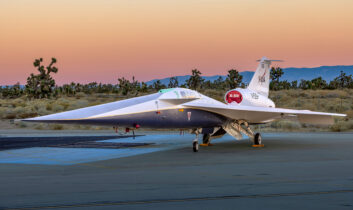The ‘Quesst’ for Quiet Skies
In collaboration with NASA’s Quesst Mission , the Lockheed Martin Skunk Works team is determined to solve one of the most persistent challenges of supersonic flight – the sonic boom. To that end, Lockheed rolled out its Quesst (Quiet SuperSonic Technology) X-59 experimental aircraft during a ceremony in early January in Palmdale, California. Rollout ceremonies are a long-standing aviation tradition, and in the case of the X-59 it celebrated technical advancements, collaboration and innovation that stemmed from years of research, development and production of a one-of-a-kind technology demonstrator aircraft that will reduce the loudness of sonic booms to a gentle thump.
The Quesst X-59 is 99.7 feet long with a 29.5-foot wingspan for a maximum takeoff weight of 32,300 pounds. Propelled by a General Electric F414 engine, it should reach a maximum speed of Mach 1.5 or 990 mph, and cruise at Mach 1.42 or 940 mph at 55,000 feet. The cockpit, ejection seat and canopy come from a Northrop T-38 and the landing gear from an F-16. With afterburner, its engine will provide 22,000 lbf of thrust.
Next, the aircraft will complete ground tests including engine-run and taxi tests before its next major milestone, first flight, later this year. After the aircraft is validated in initial flight tests, it will move into the acoustic testing phase. This phase will include flights over populated areas to provide U.S. and international regulators with statistically valid data required to help approve new rules that could allow quiet commercial supersonic flight over land. This would cut commercial flight times to half of what they are today, transforming travel for people around the world.
















































